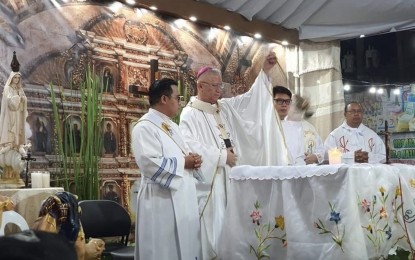
MISA DE GALLO. Cebu Archbishop Jose S. Palma celebrates the traditional Misa de Gallo at the Carbon Public Market on Monday (Dec. 16, 2019. Palma emphasized the Philippine Roman Catholic Church's theme for 2020, the "Year of the Ecumenism, Interreligious Dialogue, and Indigenous Peoples" in his homily to hundreds of vendors and market-goers who attended the dawn mass. (Photo courtesy of the Cebu City Vice Mayor's Office)
CEBU CITY -- Archbishop Jose S. Palma on Monday highlighted interreligious dialogue during the kickoff of the traditional nine-day Misa de Gallo leading to Christmas Eve in front of hundreds of vendors and market-goers at the Carbon Public Market here.
“All of us who belong to different religions, if you may, there is unity and there should be no quarrel. Why would we fight with each other when we all believe in God?” Palma said in his homily delivered in Cebuano.
The Roman Catholic Church in the Philippines celebrates 2020 as “Year of the Ecumenism, Interreligious Dialogue, and Indigenous Peoples” which kicked off on Dec. 1, the first Sunday of Advent that marked the start of the new liturgical calendar.
On Nov. 13, 2019, the Catholic Bishops’ Conference of the Philippines (CBCP) issued Circular 19-29 informing the bishops and diocesan administrators in the country about the official logo, theme, objectives and prayers in relation to 2020 as year for ecumenism, interreligious dialogue and indigenous peoples.
In the homily, Palma pressed church leaders of different religions to unite for the good of the believers.
“The point is, do not criticize other religions. Do not convert (people of other faith). Be a good Muslim, be a good Latter-Day Saints (LDS), be a good Buddhist. Let’s foster fraternity and friendship,” he said. “There are many things that unite (rather) than the things that divide.”
He said the Archdiocese of Cebu has been hosting “breakfast meeting for unity” with pastors, imams, ministers, and leaders of around 20 different religions like the United Church of Christ in the Philippines (UCCP), LDS, and Buddhist, among other denominations.
The 69-year-old head of over four million Roman Catholics in Cebu prodded religious leaders to do joint projects that have an impact on the common people.
“There are many things that transcend religion. We can do something which are much better than talking about religion. Let us do project that can benefit the community like planting of trees,” he said.
Palma told the attendees of the first day of this year’s Misa de Gallo in Cebu’s biggest public market that Pope Francis celebrated the first dawn mass at the St. Peter’s Basilica for Rome’s Filipino community.
The Vatican has recognized the traditional nine-day dawn masses up to the Christmas Eve as a significant Filipino tradition, he said.
He said Cebuanos have a “special privilege” from God through the gift of the image of Sto. Niño by Spaniards on April 14, 1521 when King Humabon and Queen Juana got baptized along with 700 other locals.
“Nganong maglipay kita? Kay ang magnunubos niabot na. Grasya sa Ginoo nga may special privilege kita sa Cebu. Ngano man? Kay sa kadaghang mga isla, 7,0000 plus, dinhi gyud gilahad ang image ni Sto. Niño pagbunyag ni Juana ug Humabon uban ang 700 ka mga sakop. … Mao nga kita sa sa Cebu ang unang mga debotos ni Sto. Niño (Why should we happy? It’s because the redeemer has come. It’s a grace from God that we got the special privilege in Cebu. Why is that? Of all the 7,000 plus islands in the country, it was here that the image was given during the baptism of Juana and Humabon along with 700 other locals… That’s why we are recognized as the first devotees of the Sto. Niño),” the bishop said. (PNA)
